Do Mechanical & Wooden Pencils Have the Same Lead Grades?
Mechanical pencils have fewer lead grades to choose from than wooden pencils because they have thinner lead.
This guide explains the difference between mechanical pencil lead and wooden pencil lead, how mechanical pencil lead is made, the mechanical pencil lead grade scale, the darkest mechanical pencil lead, and much more.
If you want to know more about colored lead for mechanical pencils, check out the Ultimate Guide to Colored Mechanical Pencil Lead for more information.
Table of Contents
- 1 Mechanical Pencil Lead Vs Wooden Pencil Lead
- 2 What is Mechanical Pencil Lead Made of?
- 3 Mechanical Pencil Lead Hardness Scale
- 4 The Hardest Mechanical Pencil Lead
- 5 The Softest Mechanical Pencil Lead
- 6 The Darkest Mechanical Pencil Lead
- 7 The Strongest Lead For Mechanical Pencils
- 8 8B Mechanical Pencil Lead
- 9 Mechanical Pencil Lead Grade Indicator
1. Mechanical Pencil Lead Vs. Wooden Pencil Lead
The lead core of a wooden pencil is approximately 2 mm in diameter. Mechanical pencils are usually much thinner, typically 0.3 mm to 0. 9 mm in diameter.
Because the lead is so thin, the lead is manufactured differently from that of wooden pencils, and there are fewer lead grades available.
The pencil’s lead also writes slightly differently due to the materials used to make the core.
Check out our Ultimate Guide to Mechanical Lead Sizes for more information on the different sizes.
2. What is a Mechanical Pencil Lead Made of?
Mechanical pencil lead is fragile compared to wooden pencil lead, and it is made from different materials to make it stronger and prevent it from breaking.
Wooden pencil lead is made from clay, graphite, grease, or wax.
- The clay binds the graphite and other materials together, and the graphite leaves a visible mark on the paper.
- Grease or wax lowers the friction between the lead core and the paper’s surface.
Check out What is Pencil Lead Made of? For more information about wooden pencil lead.
The downside of this type of lead is that it is not very strong, but it does not matter much as it is significant in diameter (approximately 2 mm).
The lead is also bonded with glue to the pencil’s protective outer wooden case to add strength and prevent breakages in a wooden pencil.
To compensate for the lead not being very strong, the lead diameter of the first mechanical pencils was around 0.9 mm.
This changed in 1962 when Pentel launched two new mechanical pencils with 0.7 mm and 0.5 mm lead diameters.
These Pencils had a new type of lead called Super High Polymer Lead.
The main difference between these and wooden pencil leads is that a polymer replaced the clay as a binder for added strength.
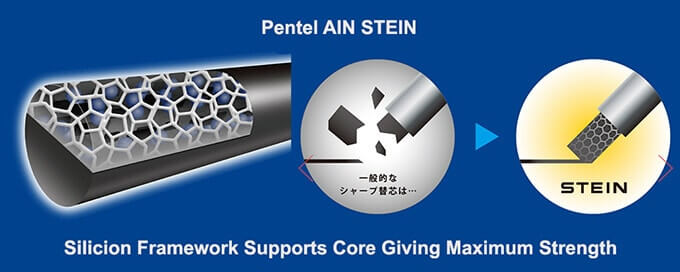
As you can see from the diagram above shows how the silicon polymers give their Pentel AIN STEIN Lead its added strength.
The other pencil manufacturers followed suit, with Faber-Castell introducing in 1967 a 0.5 mm mechanical pencil with 0.5 polymer lead.
Staedtler followed them in 1967 by introducing their 0.5 mm pencil and polymer lead refills.
Check out our Ultimate Guide To The Best Mechanical Pencil Lead for more information on Pentel AIN STEIN and the other top lead brands.
3. Mechanical Pencil Lead Hardness Scale
The main difference between the mechanical pencil lead hardness scale and the wooden pencil lead grade scale is that fewer grades are available due to the thinness of the lead compared to a wooden pencil lead core.
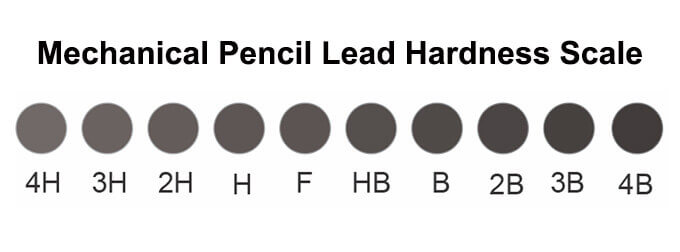
Instead of 24 Grades from 10H – 12B, there are only ten grades from 4H -4B
The mechanical pencil lead grade scale uses the same values H (hardness) & B blackness) as the standard pencil lead hardness scale.
These are combined with a number to represent how hard or soft the pencil lead is.
With H grades having harder lead and writing a light grey color
And B grades have a softer lead that writes a darker black color. For more information we cover this in detail in our Ultimate Guide to Choosing Mechanical Pencil Lead Grades
4. The Hardest Mechanical Pencil Lead
As you can see from the mechanical lead hardness chart, 4H is the hardest mechanical pencil lead grade. It is used for drafting and technical drawing.
It is not popular; manufacturers only make it for 0.5 mm mechanical pencils.
Pentel, Pilot, and Uni are the leading manufacturers making 4H lead refills.
5. The Softest Mechanical Pencil Lead
The softest mechanical pencil lead grade is 4B because of the thin diameter of mechanical pencil lead compared to wooden pencil lead.
If the lead were any softer, i.e., 6B, it would be unusable as it would be too soft to work in a mechanical pencil without breaking.
6. The Darkest Mechanical Pencil Lead
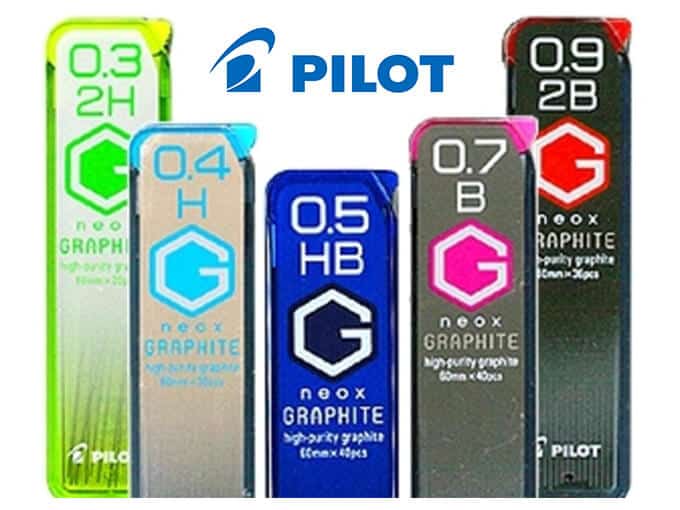
The darkest mechanical pencil lead is 4B, with Pilot Neox Graphite lead being highly recommended online for being particularly dark compared to the other lead brands.
7. The Strongest Lead For Mechanical Pencils
The strength of pencil lead increase with the diameter of the pencil size, i.e., 0.7 mm lead has a greater diameter than 0.5 mm lead and is, therefore, more robust.
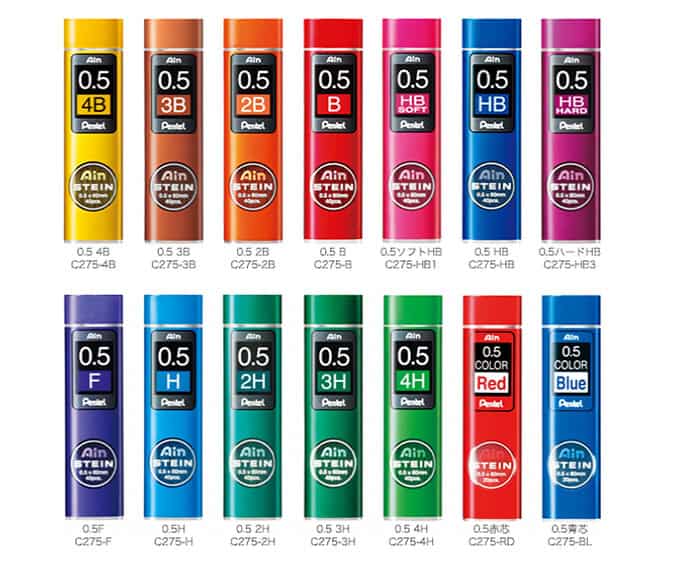
Regarding which brand of mechanical pencil lead is the strongest, Pentel AIN STEIN is widely regarded as the most robust mechanical pencil lead compared to the other brands.
8. 8B Mechanical Pencil Lead
As we have already seen, the softest mechanical pencil lead grade is 4B, only available for 0.5 mm pencils.
Clutch pencils or lead holders are mechanical pencils that take 2.0 mm lead refills.

Koh_Noor is the only company that makes 2.0 mm 8B lead for mechanical pencils.
9. Mechanical Pencil Lead Grade Indicator
General-purpose writing pencils usually don’t have a lead grade indicator, with the lead diameter marked on the barrel or cap.
However, drafting pencils will likely have a lead grade indicator in the cap.
Drafters will likely have several of the same make of pencils with different lead grades in them.
A lead grade indicator helps them to quickly identify which grade of lead is fitted to the pencil.
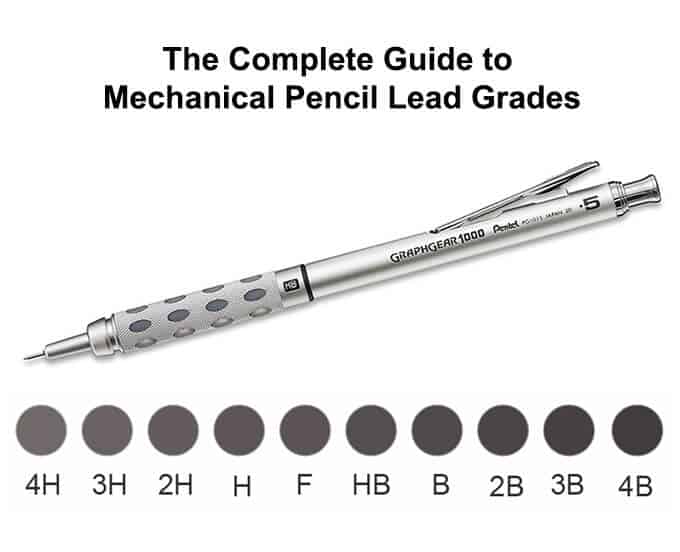
Thank you! I understand now. I have a lot of unusable refill leads.
On my wish list is a mechanical pencil that will produce fine, dark print, easy to erase, that will not make indentions in thin paper. I am currently using a kuru toga .5. The print is a little light and does make indentions. This may be the best I can do, but I’m wondering if there is an alternative. Thanks.
Is there some kind of gauge to measure the diameter of leads for mechanical pencils?
I have inherited a job lot of such pencils but am having trouble sourcing the correct size leads. This is particularly the case for a 4-colour mechanical pencil with protruding barrels for each colour. Any advice available would be welcome along wuth sources selling such items.
I use a digital caliper to size leads. Works perfectly.J
As an artist a variety from dark to light is key with a very dark dark being heaven. My search and chronic annoyance is that I cannot find MATTE or carbon black mechanical leads in .03, .05, .07 and .09! Thoughts?
Finding the right paper to go with a given pencil lead grade is the key, and there is nowhere on the internet that discusses this. I stumbled upon an old dot matrix paper years ago, and if you use a 2B mechanical lead with it, it will astonish you. It is an absolute pleasure to write with it, and I’m sure draw as well, but I’m not an artist. So dark, smooth, easy to erase… it’s like you’re writing with a pen. I wouldn’t write a letter with it, but I take notes all day, and it’s perfect for that use. But my point is this: a standard 20 lb white paper using the 2B lead is too light for me. But write on paper with a subtly rougher texture to it, and then the paper pulls more lead off of the pencil. Mmwah!
Old mechanical pencils I have do NOT have the lead diameter noted. How do I determine size when it is time to refill? Do I need a micrometer? Can I try to push the lead into the orifice the and if it fits, I am good to go?
I would try and gently push a lead that you think is the correct size slowly gently back up in the lead sleeve as the correct size should be a good fit. too big and it will not go, too small and it will be too loose. check out our guide to mechanical lead sizes for more info.
I’m looking at a BIC right now that is probably 25 years old and the clip reads:
BIC Pencil #2
0.7mm
I remember this pretty much being the standard of the era and lead was pretty much interchangable with different brands. I’d bet on 0.7mm for the typical old school cheapo mechanical pencils.